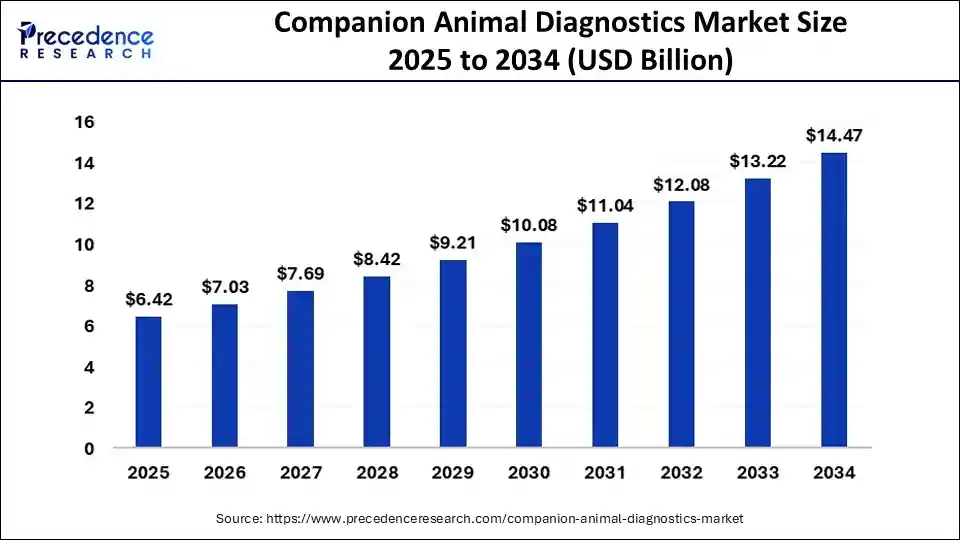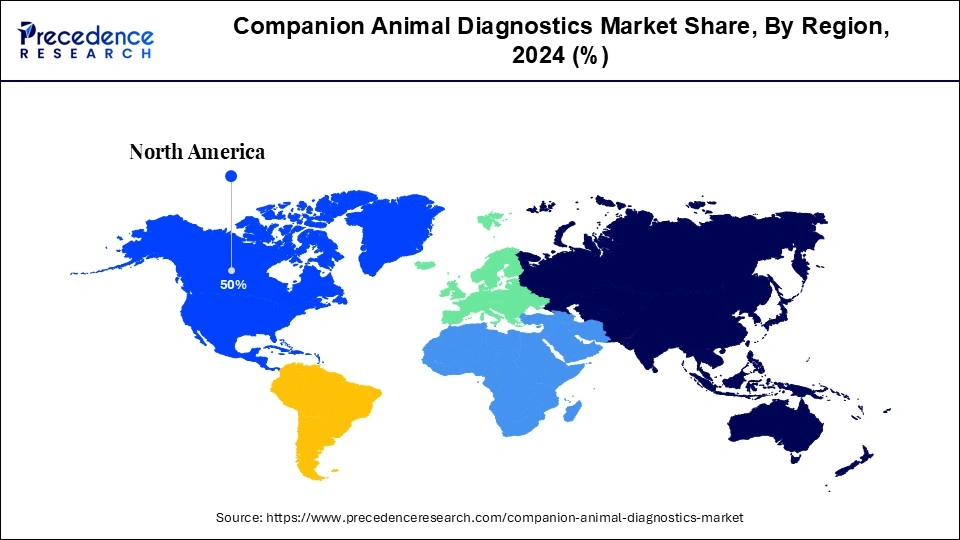November 2024
Companion Animal Diagnostics Market (By Technology: Clinical Biochemistry, Clinical Chemistry Analyzers, Glucose Monitoring, Immunodiagnostics, Hematology, Molecular Diagnostics, Urinalysis, Others; By Animal Type: Dogs, Cats, Equine; By Application: Clinical Pathology, Bacteriology, Parasitology, Others; By End-use: Laboratories, Veterinary Hospitals & Clinics, Point-of-Care/in-House Testing, Others) - Global Industry Analysis, Size, Share, Growth, Trends, Regional Outlook, and Forecast 2024-2033
The global companion animal diagnostics market size was valued at USD 3.31 billion in 2023 and is anticipated to reach around USD 7.44 billion by 2033, growing at a CAGR of 8.42% from 2024 to 2033. Increasing the prevalence of chronic diseases demanding effective diagnostics in pet animals is projected to fuel the growth of the companion animal diagnostics market.

Companion Animal Diagnostics Market Overview
A companion diagnostic, often an in vitro device, provides the essential information for the safe and effective use of a corresponding medicine or biological product. This test assists medical professionals in assessing whether the benefits of a specific medicinal product to patients outweigh any potential serious risks or side effects. The companion animal diagnostics market expansion is primarily driven by the rising demand for pet insurance, an increasing number of companion animals, and a growing number of veterinarians in developed countries. In recent years, the cost of pet healthcare, including pet food, supplies, over-the-counter medications, veterinary services, pet insurance, and other services like companion animal diagnostics, has significantly increased. Due to the substantial rise in pet care expenses, many pet owners, particularly in major markets across North America and Europe, are investing in pet insurance.
| Report Coverage | Details |
| Companion Animal Diagnostics Market Size in 2023 | USD 3.31 Billion |
| Companion Animal Diagnostics Market Size in 2024 | USD 3.59 Billion |
| Companion Animal Diagnostics Market Size by 2033 | USD 7.44 Billion |
| Companion Animal Diagnostics Market Growth Rate | CAGR of 8.42% from 2024 to 2033 |
| Largest Market | North America |
| Base Year | 2023 |
| Forecast Period | 2024 to 2033 |
| Segments Covered | Technology, Animal Type, Application, End-use, and Regions |
| Regions Covered | North America, Europe, Asia-Pacific, Latin America, and Middle East & Africa |
Driver: The rising popularity of rapid tests
Rapid tests are gaining popularity among end users due to their ease of use, specificity, repeatability, and low cost. Companies are increasingly focusing on introducing rapid tests that can provide definitive results in less than 24 hours or even during the initial examination of the animal. Moreover, the growing demand for innovative technologies that offer quick results and real-time diagnostic convenience is expected to create significant opportunities for market participants. Spending on pet healthcare has surged dramatically in recent years, including the purchase of pet food, supplies, over-the-counter medications, veterinary treatment, pet insurance, and other services such as companion animal diagnostic services.
Restraint: Lack of infrastructure
Companion animal diagnostic products can be costly, varying significantly depending on the pet. The primary expenses include initial costs and healthcare costs, with diagnostic fees being especially high for exotic breeds and severe injuries. Diagnostic costs are often the most significant financial burden for pet owners. Various studies indicate that the average veterinary visit can range from $50 to $400. Therefore, these expenses can limit pet adoption among middle-income consumers.
Opportunity: AI-powered urinalysis
Integrating artificial intelligence (AI) into diagnostic platforms marks a transformative opportunity for the companion animal diagnostics market. Vetscan Imagyst is the first AI-driven technology to offer five applications on a single platform, including AI urine sediment analysis. This innovation streamlines diagnostic workflows and enables timely and accurate pet treatment decisions.
The expansion of diagnostic capabilities to point-of-care settings, as demonstrated by Vetscan Imagyst, presents a unique growth avenue. Point-of-care diagnostics allow veterinarians to conduct in-clinic sediment analysis of fresh urine, significantly reducing the time required to obtain results. This approach aligns with the need for rapid diagnostics, contributing to better patient outcomes. The application of AI in urine sediment analysis covers elements such as red and white blood cells, epithelial cells, casts, crystals, and bacteria and offers a comprehensive solution for urinalysis.
The dogs segment dominated the companion animal diagnostics market in 2023. The growth of the segment is attributed to the rising incidence of obesity, diabetes, cancer, and other major diseases among dogs has significantly driven segment growth. Obesity increases the risk of joint problems, cancer, diabetes mellitus, and other chronic conditions. The surge in animal healthcare spending, especially in developed regions, further propels this growth. Additionally, rising awareness among pet owners has led to more frequent glucose level diagnoses by increasing the demand for glucose monitors.
The equine segment is expected to show the fastest growth over the projected period. The declining preference for horses as companion animals due to their higher maintenance needs and associated expenditures has influenced market trends. Despite this, many advanced diagnostic tests are available for equine diseases such as West Nile Virus (WNV), influenza, and anemia. Companies like IDEXX and Heska offer in-house analyzers for various tests, including hematology, immunology, chemistry, and blood gas, applicable to multiple species. This availability of sophisticated diagnostic tools supports ongoing healthcare for a range of animals despite shifts in companion animal preferences.
The clinical pathology segment dominated the companion animal diagnostics market in 2023. The rising number of pathology tests conducted on pets is a significant factor driving market growth. The clinical pathology sector encompasses various fields, including hematology, clinical chemistry, immunohematology, cytopathology, urinalysis, coagulation, endocrinology, and general pathology. Increasing pet owners' concern about their pets' health has led to heightened demand for innovative diagnostic devices. This growing focus on comprehensive pet healthcare underscores the need for advanced diagnostic solutions.
The clinical biochemistry segment dominated the companion animal diagnostics market in 2023. Clinical biochemistry plays a crucial role in diagnosing and tracking the progression of zoological diseases by analyzing blood plasma for various chemicals, including substrates, hormones, and enzymes. The rising demand for advanced veterinary care, coupled with the introduction of micro methods, is expected to drive further growth in this field. Additionally, the increasing incidence of chronic diseases in pets, such as diabetes and liver diseases, is anticipated to boost the demand for advanced clinical biochemistry solutions.
The molecular diagnostics segment will experience rapid growth in the companion animal diagnostics market over the projected period. Molecular diagnostics is emerging as a transformative force that contributes to comprehensive diagnostic solutions. Its integration into platforms like Zoetis signifies a shift towards more efficient and rapid diagnostic procedures.
The laboratories segment dominated the companion animal diagnostics market in 2023. Diagnostic facilities conduct various tests to identify the sources of companion animals. These specialized centers, known as animal diagnostics laboratories, offer effective diagnostic procedures for multiple species. They provide veterinary diagnostics to pet owners and support government-related programs or research collaborations.
The veterinary hospitals & clinics segment is projected to expand significantly in the companion animal diagnostics market over the forecast period. Hospitals and clinics specializing in veterinary health offer a wide array of diagnostic services to pet owners. These services include advanced diagnostic imaging systems like 4D imaging and related software. They ensure effective therapeutics through innovative diagnostic imaging, novel therapies, nuclear and regenerative medicines, laser diagnosis, and specialized surgeries.
North America dominated the companion animal diagnostics market in 2023. The region's advantageous healthcare structure and expanding government efforts have driven an increase in veterinary healthcare expenditure, establishing it as the top revenue stakeholder in the global veterinary diagnostic market. Rapid advancements in bioreactors, reagents, supplies, and other biocatalytic equipment are expected to further drive regional growth. Furthermore, increased R&D spending on technologies such as cultured cell engineering for companion animal diagnostics is anticipated to significantly boost the regional market.

Asia Pacific is expected to host the fastest-growing companion animal diagnostics market in the coming years. This is due to the increasing middle-class population, urbanization, and growing awareness of pet health in countries like China and India. The market for companion animal diagnostics is changing, with more emphasis on preventative care practices. As a result, this region is projected to see significant growth in companion animal diagnostics, driven by a growing pet population and a shift towards more responsible and informed pet healthcare.
Segments Covered in the Report
By Technology
By Animal Type
By Application
By End-use
By Geography
For inquiries regarding discounts, bulk purchases, or customization requests, please contact us at sales@precedenceresearch.com
No cookie-cutter, only authentic analysis – take the 1st step to become a Precedence Research client
November 2024
March 2025
March 2025
December 2024